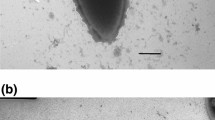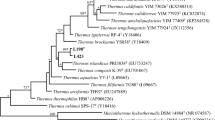Abstract
Two strains, JW 200 and JW 201, of an extreme thermophilic, non-spore-forming anaerobic bacterium were isolated from alkaline and slightly acidic hot springs located in Yellowstone National Park. Both strains were peritrichously flagellated rods. Cell size varied from 0.5–0.8 by 4–100 μm; coccoid-shaped cells of about 1 μm in diameter frequently occurred. Division was often unequal. Spheroplast-like forms were visible at the late logarithmic growth phase. The Gram reaction was variable. The DNA base composition of the two strains was between 37 and 39 mol% guanine plus cytosine as determined by buoyant density measurements and approximately 32% by the thermal denaturation method. The main fermentation products from hexoses were ethanol and CO2. Growth occurred between 37 and 78°C and from pH 4.4 to 9.8. The name Thermoanaerobacter ethanolicus gen. nov., spec. nov. was proposed for the two, new isolates. Strain JW 200 was designated as the type strain.
Similar content being viewed by others
References
Atkinson A, Ellwood DC, Evans CGT, Yeo RG (1975) Production of alcohol by Bacillus stearothermophilus. Biotechnol Bioeng 17:1375–1377
Beuscher N, Mayer F, Gottschalk G (1974) Citrate lyase from Rhodopseudomonas gelatinosa: Purification, electron microscopy and subunit structure. Arch. Microbiol 100:307–328
Bryant MP, Robinson IM (1961) An improved nonselective culture medium for ruminal bacteria and its use in determining diurnal variation in numbers of bacteria in the rumen. J Dairy Sci 44:1446–1456
Carr JG (1974) Genus Zymomonas Kluyver and van Niel 1936. In: Buchanan RE, Gibbons NE (eds) Bergey's manual of determinative bacteriology. 8th ed. Williams and Wilkins. Baltimore, pp 352–353
Enebo L (1954) Studies in cellulose decomposition by an anaerobic thermophilic bacterium and two associated non-cellulolytic species. The Royal Inst Technology. Stockholm Sweden
Frasca JM, Parks VR (1965) A routine technique for double-staining ultrathin sections using uranyl and lead salts. J Cell Biol 25:157–161
Heinen UJ, Heinen W (1972) Characteristics and properties of a caldoactive bacterium producing extracellular enzymes and two related strains. Arch Mikrobiol 82:1–23
Holdeman LV, Moore WEC, (eds) (1975) Anaerobe Laboratory Manual 3rd ed. Virginia Polytechnic Institute and State University, Blacksburg, Virginia 24061, USA
Hollaus F, Sleytr U (1972) On the taxonomy and fine structure of some hyperthermophilic saccharolytic clostridia. Arch Mikrobiol 86:129–146
Humphreys WJ (1975) Drying soft biological tissue for scanning electron microscopy. In: Johari O, Corvin I (eds) Scanning Electron Microscopy, IIT Research Institute Chicago
Hungate RE (1950) The anaerobic mesophilic cellulolytic bacteria. Bacteriol Rev 14:1–49
Kellenberger E, Ryter A, Sechaud J (1958) Electron microscope study of DNA-containing plasma II. Vegetative and mature phage DNA as compared with normal bacterial nucleoids in different physiological states. J Biophys Biochem Cytol 4:671–678
Klaushofer H, Parkkinen E (1965) Zur Frage der Bedeutung aerober und anaerober thermophiler Sporenbildner als Infektionsursache in Rübenzucker-Fabriken. I. Clostridium thermohydrosulfuricum, eine neue Art eines saccharoseabbauenden, thermophilen, schwefelwasserstoff bildenden Clostridiums. Zuckerind 15:445–449
Ljungdahl LG (1979) Physiology of thermophilic bacteria. In: Rose AH, Morris JG (eds) Adv. Microbial Physiology, Vol. 19. Academic Press, London, pp 149–243
Lounatmaa K, Makela PH, Sarvas M (1976) Effect of polymyxin on the ultrastructure of the outer membrane of wild-type and polymyxinresistant strains of Salmonella. J Bacteriol 127:1400–1407
Matteuzzi D, Hollaus F, Biavati B (1978) Proposal of neotype for Clostridium thermohydrosulfuricum and the merging of Clostridium tartarivorum with Clostridium thermosaccharolyticum. Int J Syst Bacteriol 28:528–531
McBee RH (1950) The anaerobic thermophilic cellulolytic bacteria. Bacteriol Rev 14:51–63
Rozanova EP, Khudyakova AI (1974) A new nonspore-forming thermophilic sulfate-reducing organism, Desulfovibrio thermophilus nov. sp. Microbiologya 43:1069–1075 (Engl Transl, pp 908-912)
Spurr AR (1969) A low-viscosity epoxy resin embedding medium for electron microscopy. J Ultrastr Res 26:31–43
Tansey MR, Brock TD (1978) Microbial life at high temperatures: ecological aspects. In: Kushner DJ (ed) Microbial life in extreme environments. Academic Press, London, pp 152–216
Valentine RC, Shapiro BM, Stadtman ER (1968) Regulation of glutamine synthetase. XII. Electron microscopy of the enzyme from Escherichia coli. Biochemistry 7:2143–2152
Venable JH, Coggeshall RA (1965) A simplified lead citrate stain for use in electron microscopy. J Cell Biol 25:407–408
Wiegel J, Ljungdahl LG, Rawson JR (1979) Isolation from soil and properties of the extreme thermophile Clostridium thermohydrosulfuricum. J Bacteriol 139:800–810
Weigel J, Mayer F (1978) Isolation of lipopolysaccharides and the effect of polymyxin B on the outer membrane of Corynebacterium autotrophicum. Arch Microbiol 118:67–69
Zeikus JG, Hegge PW, Anderson MA (1979) Thermoanaerobium brockii gen. nov. and sp. nov., a new chemoorganotrophic, caldoactive, anaerobic bacterium. Arch Microbiol 122:41–48
Zeikus JG, Wolfe RS (1972) Methanobacterium thermoautotrophicus sp. n., an anaerobic autotrophic extreme thermophile. J Bacteriol 109:707–713
Author information
Authors and Affiliations
Rights and permissions
About this article
Cite this article
Wiegel, J., Ljungdahl, L.G. Thermoanaerobacter ethanolicus gen. nov., spec. nov., a new, extreme thermophilic, anaerobic bacterium. Arch Microbiol 128, 343–348 (1981). https://doi.org/10.1007/BF00405910
Received:
Issue Date:
DOI: https://doi.org/10.1007/BF00405910




